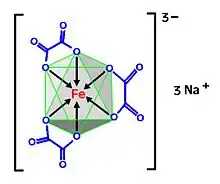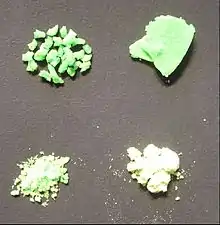Sodium ferrioxalate
Sodium ferrioxalate is a chemical compound with the formula Na
3Fe(C
2O
4)
3. It is also called sodium oxalatoferrate or sodium trisoxalatoferrate.
 | |
| Names | |
|---|---|
| IUPAC name
Sodium iron(III) oxalate | |
| Other names
Sodium ferrioxalate Sodium ferric oxalate | |
| Identifiers | |
3D model (JSmol) |
|
| ChemSpider | |
| EC Number |
|
PubChem CID |
|
| |
| |
| Properties | |
| C6FeNa3O12 | |
| Molar mass | 388.868 g·mol−1 |
| Density | 1.97 g/cm3 at 17 °C |
| 32.5pts per 100pts solvent, cold water, 182pts per 100pts, boiling water[1] | |
| Structure | |
| octahedral | |
| 0 D | |
| Hazards | |
| Main hazards | Corrosive. Eye, respiratory and skin irritant. |
| GHS pictograms |  |
| GHS Signal word | Warning |
| H302, H312 | |
| P264, P270, P280, P301+312, P302+352, P312, P322, P330, P363, P501 | |
| Related compounds | |
Other anions |
Potassium ferrioxalate |
Related compounds |
Iron(II) oxalate Iron(III) oxalate |
Except where otherwise noted, data are given for materials in their standard state (at 25 °C [77 °F], 100 kPa). | |
| Infobox references | |
The compound is a salt consisting of ferrioxalate anions, [Fe(C
2O
4)
3]3−, and sodium cations Na+. The anion is a transition metal complex consisting of an iron atom in the +3 oxidation state and three bidentate oxalate ions C
2O2−
4 anions acting as ligands.
The ferrioxalate anion is sensitive to light and higher-energy electromagnetic radiation, which causes the decomposition of one oxalate to carbon dioxide CO
2 and reduction of the iron(III) atom to iron(II).
Properties
Solubility
This compound is very soluble in hot water, (182 parts per 100 parts solvent by mass), but a lot less soluble in cold water, (32 parts per 100 parts solvent), about the solubility of sodium chloride. It is not appreciably soluble in ethanol or ethanol water mixtures which are more than 50% ethanol by mass. It is somewhat more soluble in water than the corresponding potassium salt.
Preparation

Sodium ferrioxalate can be obtained by mixing solutions of sodium oxalate and ferric oxalate, and waiting a few hours for the brown colour of the ferric oxalate to be replaced with the green colour of the complex anion.
- 3 Na
2C
2O
4 + Fe
2(C
2O
4)
3 → 2 Na
3[Fe(C
2O
4)
3]
The equilibrium is attained only slowly at room temperature. The product can then be crystallized by evaporating the solution at just below boiling until small crystals appear, then allowing it to cool. The product may also be precipitated by adding methanol or ethanol to the solution.
Some decomposition of the ferric oxalate may occur during the process, resulting in the canary-yellow insoluble iron(II) oxalate. Small amounts of hydrogen peroxide H
2O
2 may be added to keep the iron in the 3+ oxidation state.
See also
A number of other iron oxalates are known
References
- Weast, Robert C., ed. (1981). CRC Handbook of Chemistry and Physics (62nd ed.). Boca Raton, FL: CRC Press. p. B-149. ISBN 0-8493-0462-8.